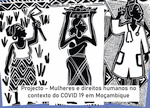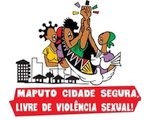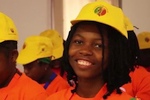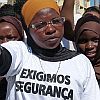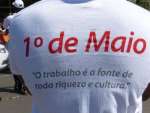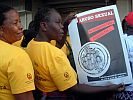Women and Home Care in an HIV and AIDS Context
Ana Maria Loforte
Introduction
Access to services is a crucial factor in health systems and has a direct impact on the well-being of the population. The main programme and strategy instruments of the Ministry of Health (MISAU) in Mozambique – the Health Sector Strategic Plan 2005-2010 and the Health Sector Gender Strategy 2009 – emphasise universal access to services, in particular primary health care based on equity and improved service quality.
MISAU considers that involving the community and other institutions in this care is essential for planning, operating and improving the use of services, complementing the work done by professionals in this field.
It has thus promoted community empowerment as a prerequisite for universal access to institutionalised care. At a time when HIV and AIDS are expanding substantially, reducing rates of new infection will come from, among other aspects, access to integrated, quality sexual and reproductive health services.
The country has introduced systems for administering anti-retroviral therapy, Vertical Transmission Prevention Programmes, Counselling Services and Voluntary Testing where activists and community leaders have a crucial role in mobilising people for adherence, diagnosis, prevention and treatment. However, the way these services and programmes function, and the way community participation is regarded are mechanical, with a short-term perspective. There is no consideration of social relations dimensions where gender inequalities predominate, and community practices and routines have not taken them into account.
This article is based on research by the Department of Archaeology and Anthropology in three districts of Maputo province (Manhiça from May to July 2010, Marracuene from June to August 2011 and Boane from October to December 2011) intended to strengthen community-based systems that support the treatment of HIV and AIDS. The article tries to show that women’s participation in the provision of health care is determined by values that affect the service provision network and implementation of the health system in the community, especially the fight against HIV and AIDS.
Interactive processes have social and political dimensions that produce specific and dynamic cultural characteristics sui generis. These processes are also shaped by habitus (Bourdieu, 1977) i.e. by a set of experiences and characteristics that mould the conduct of members of the community, supporting or constraining the provision of home care services.
The research challenges
The HIV prevalence rate in Mozambique is 11.1%; the rate for women is 13.4% and for men 9.2%. According to Mozambique’s Socio-Demographic Indicators (UNFPA, 2011) the highest rates are in the southern provinces, reaching 20% in Maputo province. These figures reveal a stark reality and show that, despite improvements in the country’s public health services, access to prevention and treatment services is still a problem.
The research used a number of qualitative techniques, in particular focus group discussions with young people, adult women, adult men, community leaders and health service workers in order to involve informants as active participants in a dynamic, interactive process while at the same time providing reflection on the implications of decisions and actions.
Involving community members as partners in the search for information was crucial not only for the description and analysis of their situation, the assessment of constraints and opportunities, but also for gathering opinions and beliefs on health and on ways of preventing and treating HIV and AIDS.
The various techniques used in the Research Protocol required lengthy analysis exercises, a lot of reflection and the discussion of ideas; the informants were not used to this.
Nevertheless, all these difficulties were a very interesting methodological challenge and contributed to understanding and comparing the difference between what is expected of community participation and the work of health services, and the day-to-day practical reality. These differences and the contradictions between what is expected and what happens on a daily basis led us to look at the spaces maintained for organising values and rules, and strategies for adhering to or breaking with imposed models of behaviour and action.
Community participation: assumptions and mechanisms
Getting to know the logic underlying the provision of services to men and women in the community, the object of our research, was guided by a theoretical framework based on a perspective that tried to understand the broader context in which distinct representations of health and sickness are moving, as well as the various ways of understanding and applying therapeutic arts in a common geographical space.
We also wanted to understand how, starting from the significance of social phenomena, men and women use their competence in a collective action to meet their needs (Weber, 2005) either by (i) incorporating new elements that at times challenge their cultural heritage, or (ii) by maintaining and reproducing values and practices they consider legitimate (Bourdieu, 1977).
Studying the structuring dynamics of institutions that provide health care also encouraged us to think about relationships. Feminist theory provided us with a conceptual framework for understanding the differences between men and women that are built into assistance practices. We thus tried to explore how gender roles, hierarchies and unequal power in access to and control over resources influence male and female skills when they participate in activities that promote health and the use of services, facilitating or creating constraints.
As Geertz (1991) reminds us, analysing communities does not mean just describing a social structure, it also means paying attention to the norms that organise them and put them in contact with others.
Medical systems
The study enabled found that a harmonised set of social institutions and traditions have been created out of preventive practices, therapies and assistance processes that function independently to preserve health. Assailed by HIV and AIDS, community members use distinctly different medication, and thus different therapeutic models, sequentially or to complement each other according to their interpretation of the disease and the social tension that this interpretation expresses.
The study districts have two service levels. The first level is the district health unit (Rural Hospital), First Aid Posts in some villages and Health Centres in Locality centres.
The second level is provided in the community by the employees and activists of national and international NGOs and by local institutions such as churches and traditional medical practitioners, traditional healers. Although the two levels remain autonomous, they co-operate and collaborate. Traditional medicine frequently refers patients to health units (HU) when they feel these facilities are more appropriate for handling certain illnesses.
As this article covers assistance practices, we shall address briefly access to biomedicine and access to homecare provided by activists.
Assistance practices
Access to biomedicine
Aware of programme and institutional weaknesses, we shall try to analyse the quality of care provided by health services and its characteristics, which have a crucial role in their acceptance by the community and their effective use. What are the obstacles?
We were told that access to these services is difficult for a variety of reasons. Firstly, there is the fact that the Rural Hospital is the only facility that can do tests forces people to travel long distances on foot or to pay for transport.
So when there is no ambulance to cover all needs, people resort to public or private transport. There is very little public transport and private transport, which is costly, refuses to carry sick people. These forms of transport can only be found on National Highway 1 because of the bad state of roads in areas where communities live, and vehicles cannot get there. Alternatively, people have to hire a vehicle to get to hospital and this is beyond the reach of most patients.
Women face additional obstacles. They rarely have their own money: the search for funds to pay for the journey is an additional barrier to their access treatment. The journey to hospital for testing or treatment can be difficult and complicated as a partner or other relatives can question the purpose of the trip. Pregnancy is considered a family matter and assistance processes must be understood in the context of the social representation of procreation and gender ideologies that dictate who accompanies a woman to a health unit or traditional healer.
Another aspect considered unacceptable for those seeking services, women in particular, is when health professionals asking indiscreet and offensive questions. Revealing few communication skills or an inability to relate to users, most of whom have little education, in addition to the questions they must ask to assess a patient’s state of health (e.g. “how old are you? How many children do you have?”), they also ask questions that have nothing to do with the assistance to be given, of the type: “What are you doing here at your age?”
Faced with these questions and verbal abuse, potential beneficiaries decide that they will not return to these services. They also tell members of the community in the same age group about their experience and they too lose interest in going to a health unit.
The structure of antenatal services for pregnant women, some of whom are HIV positive, inhibits their use. In one of the villages studied, the room allocated for this care was a corridor containing other patience where conversations can be heard quite clearly. Women avoid going to pregnancy consultations.
Those who manage to reach the Rural Hospital face other obstacles to accessing services. One of these is the huge demand for services that results in delays in being assisted and long queues.
The fact that there are no services exclusively for matters linked to HIV and AIDS was another problem presented as an obstacle. The stigma of AIDS can increase people’s fear of being humiliated and ill treated.
We also found that having access to information on how these services work can be a first step in prevention and treatment, as it has the potential for creating affinity with the medical discourse. Nevertheless, taking a decision or choosing requires additional changes that arise from greater autonomy and the ability to act (agency).
Putting into practice information on prevention and treatment frequently requires creating opportunities that enable vulnerable people to develop their capacities through access to health and remunerated work.
People are aware that there are effective therapeutic resources in the Rural Hospital but local acceptance criteria are influenced by distance and by service routines. The acknowledged benefits must be correlated with perceived and experienced obstacles – transport costs and the quality of the service provided.
Under these circumstances and given the logic of the double causality level of illness, action by other providers is relevant. It provides two therapeutic channels (using non-medical institutions such as the Zion Church that practices exorcism to expel evil spirits or traditional healers) and intervention by activists.
Activists and homecare
Various national and foreign organisations are working on prevention. For example, by 2010 the Provincial Nucleus for Fighting AIDS in Maputo was working with a network of 400 NGOs with programmes, some of which were intended to produce rapid results and were considered “emergency programmes”. Today, however, following cuts in funding there are only 160 organisations.
The aim of some of these organisations’ projects is to strengthen community-based care for people living with HIV, antenatal and postnatal care for women, and support for orphans and vulnerable children and their families. They are working to improve the population’s health and quality of life through community assistance activities in the fight against chronic and infectious diseases. They function as channels for transmitting new knowledge: providing materials on preventing HIV, lecturers and distributing posters.
Prevention strategies focus on distributing information about forms of contagion and the need to use a condom. The idea is that access to information is the first step in changing individual behaviour or that changes in behaviour that bring health benefits are sufficiently attractive to be adopted without hesitation.
Communities, however, feel that a condom is unacceptable for husband-wife relations. Sexual relations must lead to procreation. Both women and men expressed their opposition to using condoms and any attempt in this respect produces challenges, suspicion and sometimes various kinds of violence. People absorb and reinterpret the biomedical information they receive according to their cultural representation systems and practices. This means that the work of providers must go beyond the transmission of information about HIV and AIDS and prescribing a condom, because users’ concepts and perceptions block their use.
In a complementary action, activists publicise the services available in health units, ways of mitigating the effects of HIV and how to get around exclusion from collective activities due to stigma and discrimination.
Mediation between communities and organisations takes place through activists who maintain regular periodic relations and identify patients. During home visits these providers give advice on strategies for continuing to live with HIV and ways of avoiding (re)infection.
Counselling is a fundamental component in preventing HIV and AIDS, as it is the entry point for treatment and psycho-social support, as well as behavioural change. Given the local system’s ability to handle AIDS cases, their work is valuable and often they are the only contact between the patient and the outside world, in cases where people have been abandoned by their families, namely, HIV positive women who are stigmatised because they have been accused of infecting their husbands.
It was also found that there is a tendency for activists linked to NGOs to be men who are paid whereas most homecare is provided by women without any fees or subsidies. These women are social actors who work with infected and affected people and open spaces for a dialogue that breaks silence, reduces stigma and facilitates access to prevention and treatment.
Women provide most of this care and for different reasons that reflect gender inequalities and power in these assistance practices:
- Providing care at home is considered a “natural” activity of women; they are considered guardians of tradition, of group norms, as they have always done; they are thus more capable of caring for patients in the correct manner;
- As men are considered “the family breadwinner”, they cannot be involved in this kind of activity without payment.
So homecare is a woman’s job in a context where femininity is built on values that emphasise subservience and dedication to others. In a vast field of male domination, a woman is dispatched to the private sphere, is devalued, disqualified and regarded as someone who does not require skills and competence.
But homecare requires attention, responsibility, acquiring social capital by investing one’s time in achieving mutual trust and interaction with members of the community. It also means taking decisions on how to provide assistance, and this involves power and authority on the part of those providing it.
Recognising the importance of care challenges the legitimacy of the unequal distribution of power and resources. Despite some progress in recognising the gender inequalities that feed the pandemic, few national responses channel financial resources for the care provided by women and girls as part of the overall fight against HIV. Their contribution to the economy through this care does not appear in macro-economic policies.
When arguing that women have a vocation for taking care of the sick, for maintaining tradition, for cultural continuity and conserving values it must be borne in mind, as Lenclud says (1987:118), that the special value of a tradition is that it enables and offers everyone that defends it, a way of affirming the differences in their everyday lives and securing their authority and power.
Final comments
The study revealed that, in addition to the clinical component that includes tending to the patient, prevention and treatment, there are a number of supporting interventions by different providers who act simultaneously or as alternates, for an integrated management of the disease. Measures are intended to maximise adherence to and the effectiveness of treatments that are essential components for medical intervention.
Many factors – including insufficient transport, the economic dependence of women in particular, lack of kindness and respect on the part of professionals in the institutional apparatus – inhibit dialogue with users or impede stronger demand for health units that permit more comprehensive biomedical coverage of HIV and SIDA, STI, prescribing and administering anti-retrovirals and getting more women involved in homecare.
However, social and economic barriers and gender and power inequalities prevent recognition and appreciation of the health services provided by the women who assist people living with HIV and AIDS.
References:
Bourdieu, P. (1977). Outline of a theory of Practice. Cambridge, Cambridge University Press.
FNUAP (2011). Indicadores Sócio Demográficos de Moçambique. Maputo.
Geertz, C. (1991). A interpretação das Culturas. Oeiras: Celta Editores.
Lenclud, G. (1987). La tradition n’est plus ce qu’elle était. In : Terrain, 9. pp. 110-123
Weber, M. (2005). Três tipos de poder e outros escritos. Lisboa: Tribuna da História.







 Information in English
Information in English